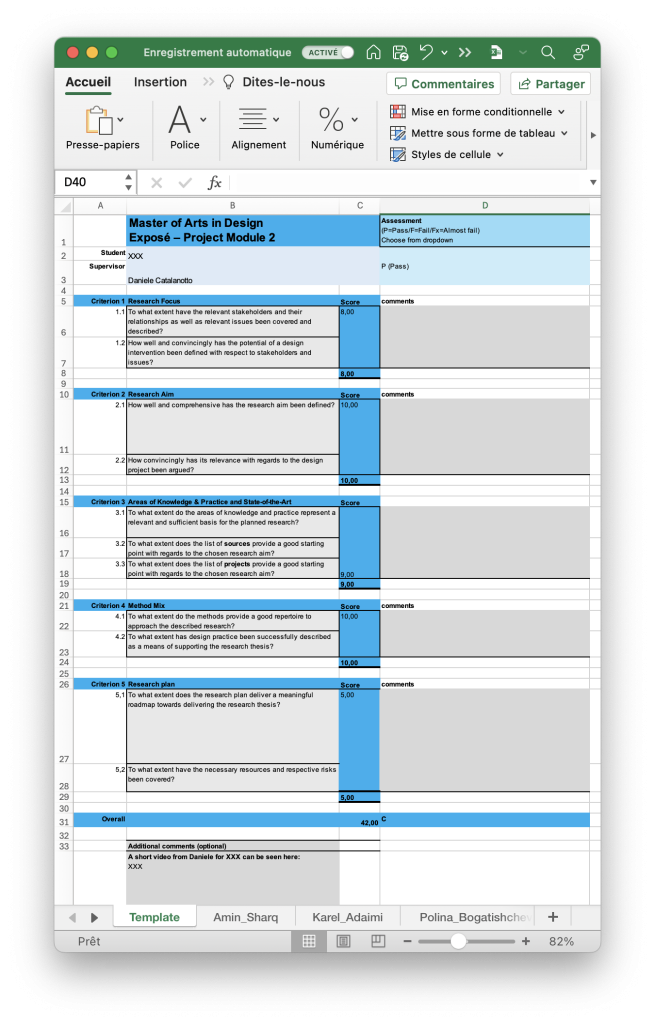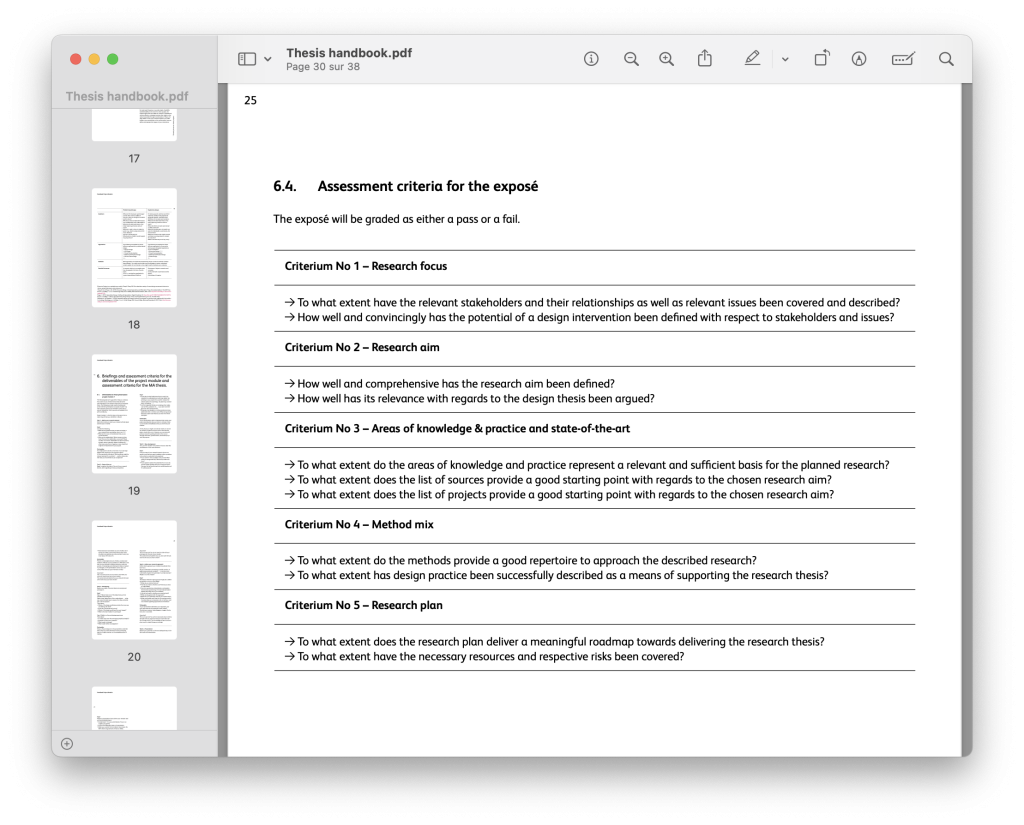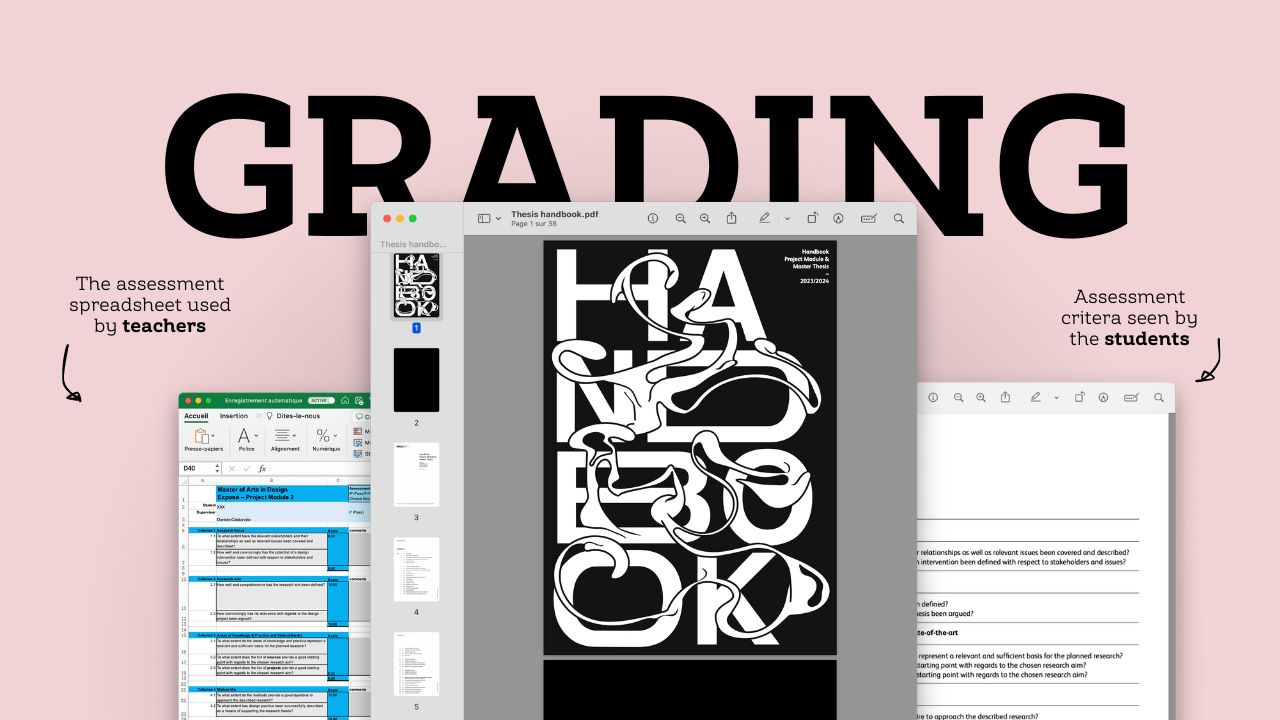In this 7-minute video, I share with you the tools used by students and teachers of the Master Service Design to grade the research thesis or academic work. I also highlight how, with three tiny experiments, we’re trying to make these administrative moments more human and emotional.
Summary: The tools used to grade academic work
The Excel Spreadsheet: A Teacher’s Tool
The teachers in the program use an Excel spreadsheet to grade academic work efficiently and provide constructive feedback to students.

The Thesis Handbook: A Student’s Guide
Each student gets the thesis handbookwhich outlines clear assessment criteria for each step of the academic work.

The criteria in this document are exactly the same as those used in the grading Excel sheet used by the teachers.
Transcript
Show the transcript
Intro
This transcript was fully generated using Descript. The transcript wasn’t corrected. Which means it can be pretty creative, funny or wrong at moments.
How do we grade academic work within the masters Service Design of the HSLU?
Hi there I am. One of the co-leads for that Service Design program. And today I want to give you a bit of a behind the scenes, look at the different documents, that both students and teachers use when it comes too grading academic work.
Story time: the history teacher that told me to write less
But first let’s start with a comment that I got 20 years ago when I was in college.
My history teacher told me:
Daniele, just be smarter. Don’t write that much. Just answer the question.
That teacher made fun of me and my peers, because we often wrote super long sentences because we thought that’s what was expected in an exam.
For example, when the question was, what are the dates of the second world war? I would write the date, but also then, add some details on it.
And that history teacher just told me:
I ask you a date, just give me the date. I don’t need more. I just need to check that you have the knowledge.
So be smart. Read the question and just answer that question.
From that day on, when I went into a history exam with him, I just answered that question without any more details. I finished my exams within 15 minutes when we had a full hour for it. I still had the same grades, but I had 45 more minutes of free time and relaxed time, which is something that you pretty enjoy when you’re in college.
As I’m now on the other wall of the student teacher wall, this memory came back to me. And I think it’s a good lens to have in mind when we speak about grading academic work.
I know enough story time.
The excel spreadsheet we use to grade academic work
So how do we grade work within the master Service Design?
It’s super straightforward for the teachers.
One of us prepares an Excel spreadsheet where we can easily add the grades and comments that can then help the students improve their work.
This Excel spreadsheet that you’re seeing is exactly the one that I’m using.
The assessement criterias students recieve in advance
But more interesting than this boring Excel spreadsheet is a document that every student gets.
Which is called the thesis handbook.
In that thesis handbook, you have clearly written assessment criteria for each step within the academic work.
These criteria is, are exactly the same that I have to use as a teacher.
If you compare the excel spreadsheet from the teacher view and the PDF from the thesis handbook that students see. You will see that they are exactly the same.
The smartest students really look at these assessment criteria and make their best to answer these elements perfectly. Because they know that’s what we will grade them on.
Obviously a good grade is something nice, but what’s even nicer is that if you follow these assessment criteria it also leads to a good academic project.
Story time: the teacher that helped me cheat
This reminds me of another teacher I had back in the days in college. And that guy did something really funny. A week before the exams, he would tell us: these are the questions of the exam.
We all looked at each other feeling, oh, this is cheating. We get the questions before the exam. That’s going to be so easy.
But you know what, in order to cheat well, and to be able to answer those questions. We had to go through all the content and learn all of it.
Which to us students felt like cheating. But in fact was focused learning.
An academic project like one from a master’s Service Design thesis is something that has many steps.
And for each of these steps, they are usually very clear assessment criteria that are made visible for the students
that are the same ones that are used by the teachers.
Making grading more human
Now you might say: Daniele this sounds very transparent and very clear. But a touch administrative.
And, I feel you. As a service designer myself. When I look at those Excel spreadsheets, I feel a bit frustrated.
Because it’s hard to showcase emotion in an excel spreadsheet.
When I review some academic work, obviously. I use my critical mind a lot, emotions, they also come. And I think they also have value.
Experiment one: Emotional video
So this year I tried a little experiment.
Obviously I fill as my Excel spreadsheet as good as I could with and good honest feedback and still some motivating words.
But in the end, I added a link to a personal video. That’s reveals, a little bit more the emotions.
This video just looks like this one.
It’s maybe one or two minutes where I address a specific student. And speak in his language when I can. And congratulate the student for first finishing that part of the work. Which is something that we always can celebrate. And then congratulate that student for passing that phase of the project.
And finally, I try to recognize some qualities that I saw in the work, which are maybe a bit more emotional, like good curiosity. Or recognize stuff that I’m not asked to grade, but I still feel is valuable.
Experiment two: starting with the good stuff
And then obviously the service designer in me plays with the little details that he can play with within the framework that is given.
So in the excel spreadsheet that I have to feel, I always try to do two more things.
The first. Is to Always start with the good stuff first. Because there is always good stuff. And that showcases that we recognize that people did some hard work and that they there are could results in it.
Experiment three: creating a heatmap to help see how good the work is
Then I do another trick: I put in bold kind of the key elements. Which didn’t give us a visual map of how good the work is.
This is especially helpful when you have to share a critique. Or our recommendation to make the work better.
This type of information takes more space to write. And therefore, if you just look at it visually from the length, you might feel that there is more criticism.
But when you then, just look at the stuff that I put in bold, on three things that are in bold two are recognitions of good work, and one is a criticism.
And therefore it creates a better balance in understanding the level of criticism that is offered. By me.
Two lessons for service designers
In these tiny experiments. I think that there are two lessons that can apply to any service designer.
For the first one we could bring back to memory my history teacher. . And he would say:
Stick to the brief
Just stick to the brief.
Give an answer to the questions that people ask you. And if you answer questions that people don’t have asked. Know that this is bonus work.
And the second lesson is that
You can always humanize work
Even within very administrative processes, we still can bring a touch of Service Design and humanity and emotions in it.


